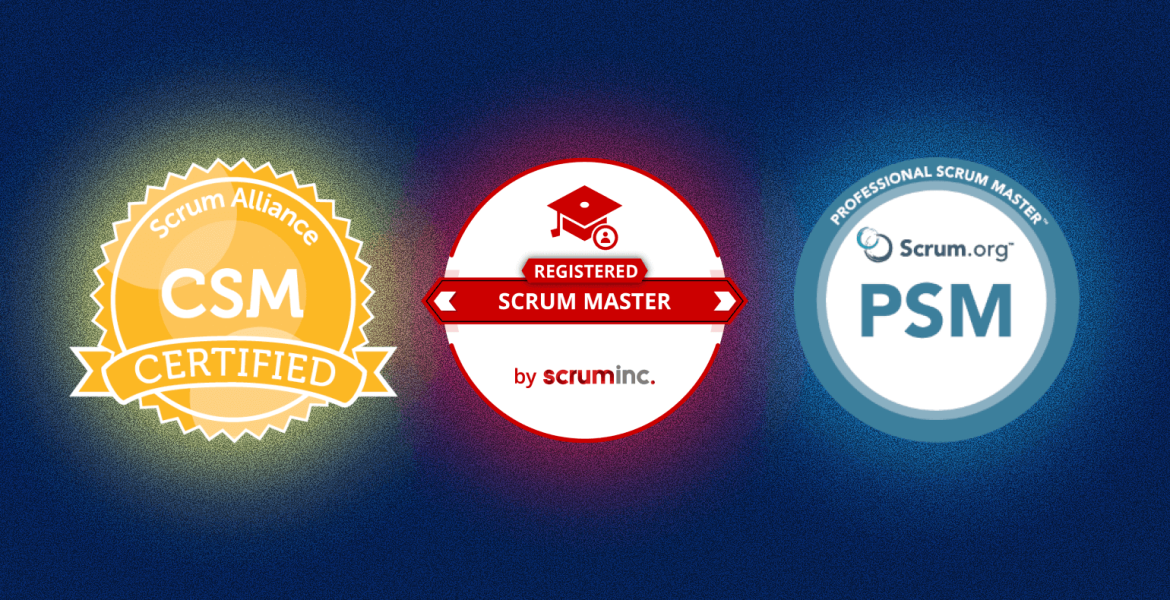What is a Scrum Master certificate and how can you get one?
Have you ever wondered how to get a Scrum Master or agile project manager certificate? Maybe you've heard about the Scrum framework and its importance in today's project management and want to step up to improve your skills and advance your career.
At Trinidad Wiseman, many specialists have acquired the Scrum Master certificate. We'll introduce you to the world of Scrum certification and describe the different ways and opportunities to get it. Read on.
What is Scrum and who is a Scrum Master?
In software development projects, agile methodology is often used. This approach applies flexibility, quick response to changes, and teamwork. This way, we can improve the efficiency and quality of solutions and ensure that the final result better meets users' needs.
There are various frameworks for implementing the agile approach. Why it's important to apply systematic development methodology in development projects is further explained in our earlier article on methodical software development.
One of the most popular of these frameworks is Scrum. Scrum encompasses a collection of set events, artefacts, and roles, which are compiled into a single document in the Scrum Guide. Each role in Scrum has defined tasks that they maintain within the framework.
One of the roles in the Scrum framework is the Scrum Master. They are the team's coach and mediator, supporting the team in implementing Scrum and ensuring the correct use of the framework.
At present, for those seeking a Scrum Master position or engaging in tender processes, presenting a certificate is often a requirement. This certificate serves as evidence that the individual has gained a comprehensive understanding of Scrum and possesses the capability to impart this knowledge to a project team implementing the Scrum framework in their project.
Levels of Scrum Master Certifications
Scrum certifications are available at different levels, reflecting certain skills and competencies. Let's take a closer look at these.
Beginner Level – these certifications are for professionals who are not yet thoroughly familiar with the Scrum framework or have limited experience in this field.
By obtaining the certification, one gains basic knowledge of Scrum principles and practices and initial practical skills. Examples of such certifications are Scrum Fundamentals Certified (SFC) and Professional Scrum Foundations (PSF).
Intermediate Level – these certifications are for professionals who already have better knowledge and practical experience with the Scrum framework and wish to further enhance their skills and knowledge. Examples include Certified Scrum Master (CSM), Professional Scrum Master I and II (PSM), and Advanced Certified ScrumMaster (A-CSM).
Advanced Level – these certifications are for experienced Scrum professionals who have demonstrated a high level of skill and competence with the Scrum framework.
These certifications often require extensive experience, a thorough understanding of Scrum principles, and successful implementation of Scrum in complex situations. Holders of this certification can also conduct trainings. Examples are Certified Scrum Professional (CSP), Professional Scrum Master III (PSM III), and Certified Scrum Trainer (CST).
Specialists at Trinidad Wiseman possess intermediate-level Scrum certifications. In addition to Scrum Master certifications, our specialists also have Scrum Product Owner certifications.
Scrum Certification Providers
For acquiring a certification, there are three reputable organizations to consider: Scrum Alliance, Scrum.org, and Scrum, Inc. Through these, you can acquire different level Scrum certifications for various Scrum roles.
The main difference between these organizations lies in their approach to certification and training. Also, the founders of the institutions are different. Scrum.org and Scrum Alliance were created in collaboration with other professionals by Ken Schwaber, while Scrum, Inc was founded by Jeff Sutherland. Both men also first adapted the Scrum framework in 1993.
The institutions also name their certifications differently - ScrumAlliance uses the “Certified” prefix, Scrum.org uses “Professional”, and Scrum, Inc uses “Registered”.
Scrum Alliance and Scrum.org issue the majority of certifications and are more renowned in this respect. We will focus on these two next. Which organization to choose for certification depends on personal preferences, training needs, and career goals.
Training:
Scrum Master training at different levels can be conducted by certified trainers. Before attending a course, it's worth checking if the trainer has the right certification, such as Certified Scrum Trainer (CST), Professional Scrum Trainer (PST), or Professional Scrum Master™ II (PSM II). This ensures that the trainer has acquired sufficient knowledge to pass it on to others.
Most Scrum Master trainings in Estonia are conducted in English and online (e.g., BCS Training, Äripäev). However, there are also trainings in Estonian (e.g., Scrum.ee; agilecoach.ee).
Training can be done individually or as a team, and also virtually through various international training platforms. When choosing a course, it's advisable to check which certification organization the training is associated with and if it aligns with your preferences.
Scrum Alliance:
Scrum Alliance offers a more flexible approach to obtaining certification. This involves participating in a training program followed by an exam. However, it places more emphasis on the business side, where renewing the certification requires more time investment and fees.
After completing the training, participants have 90 days to take a multiple-choice exam. To prepare for the exam, you can find practice exams online to test your knowledge.
The exam tests understanding of Scrum principles, roles, teamwork, and practical implementation. The exam consists of 50 questions with one hour to answer. To pass, you need to correctly answer 74% of the questions.
Trinidad Wiseman specialist Rauno on obtaining the Scrum Master certificate:
„I completed the Scrum Master training through the Knowledgehut training platform. There, I found a wide selection of courses with different schedules and was able to review feedback about the trainers and courses.
The training was in English and conducted virtually over a 3-day period. The Miro platform was used, allowing me and other participants to engage in various exercises and acquire knowledge. At the same time, it was possible to talk to the trainer and ask questions. The training also involved homework to be completed for the next day.
After the training, I took the exam, which I was comfortably able to prepare for through the platform's practice exams. The exam was open-book, and since everything was fresh in my mind, I found it straightforward.“
Trinidad Wiseman specialist Kadi shares her experience:
„I chose Knowledgehut for my Scrum Master certification. I had previously completed a Scrum Product Owner training in Estonia (Scrum Alliance) and knew what to expect from the new training. I got the recommendation for this platform from a friend who had recently completed their Scrum Master training there.
After selecting the training date, I researched the trainer's background thoroughly. Through the trainer, I also found a Scrum community for exchanging ideas with other project managers worldwide. The training was interactive, using the Miro platform and video calls.
The diversity of participants in terms of their background made some exercises challenging. We had to keep our cameras on during the three-day training, which the trainer monitored regularly. The training provided recommendations for useful articles and books, as well as websites for tools to conduct Scrum events (e.g., retrospectives).
The exam immediately after the training was straightforward. The use of resources like the Scrum Guide, the framework's foundational document, was allowed. The training definitely helped me get a better overview of the Scrum Master role and sparked ideas on how to successfully implement Scrum in Trinidad Wiseman's projects“.
Scrum Alliance certificates need to be renewed every two years. This can be done by learning, actively participating in the community, or attending events organized by Scrum Alliance. This ensures that the certificate is not just "sitting in a drawer" but encourages active engagement for its maintenance.
Additionally, a fee (100 USD) is required for renewing the certification. Alternatively, your existing certificate can also be renewed by obtaining a Scrum Master or another Scrum role certificate at the same or a higher level.
Scrum.org:
This organization focuses more on personal development, while also emphasizing a stricter and more standardized approach to Scrum certification. Unlike Scrum Alliance, Scrum.org doesn't place as much emphasis on the business aspect. Like Scrum Alliance, Scrum.org also requires passing an exam to obtain certification.
You can prepare for the exam independently without undergoing training, or you can choose to find a suitable preparation course if preferred. The exam consists of 80 questions and must be completed within one hour.
The passing threshold for Scrum.org's exam is higher at 85%, compared to Scrum Alliance's exams. Although open materials may be used, the exam is somewhat more challenging and requires more precise knowledge of Scrum than the Scrum Alliance exam.
Renewing the first-level Professional Scrum Master (PSM) certification through Scrum.org costs $200 per attempt. This means that each time the exam is not passed, the fee must be paid again. Unlike Scrum Alliance certificates, Scrum.org certificates do not need to be renewed.
Trinidad Wiseman analyst Lilian shares her experience in preparing for and passing the exam:
“I got the initial idea to pursue the Scrum Master certification during a university lecture introducing agile methodology, where various methodologies and roles were described. After the lecture, as I researched more about the Scrum Master role, it became increasingly appealing to me, and I eventually decided to pursue this certification.
I weighed both Scrum Alliance and Scrum.org certifications, and whether to study for the exam on my own or attend a training course. I ultimately chose Scrum.org because the Scrum Alliance system, which requires renewing the certificate every few years, seemed complicated and expensive. I also decided not to attend a training course and instead study on my own, as I wanted to acquire knowledge at my own pace.
In preparing for the exam, I thoroughly worked through the Scrum Guide and browsed other materials available online, such as on the 5D Vision page. I also completed several free practice exams available online. It's worth mentioning that the practice exams were significantly easier than the actual exam, both in terms of question structure and time limits.
Therefore, achieving maximum results in these practice tests does not guarantee the same score in the actual exam. The most important thing is to understand Scrum principles while studying different materials, and then you can use logical thinking to pass the exam and successfully apply what you've learned.”
Options for Obtaining Certification
In summary, there are three ways to obtain a certification:
- Participate in a training course offered by a Scrum certification organization, through which you can take an exam and obtain the certification.
- Attend a training course offered by trainers not affiliated with any Scrum certification institution and take the exam through Scrum.org.
- Learn about Scrum on your own, focusing on the Scrum Master role, and take the exam through Scrum.org.
What’s Next?
If you've obtained your certificate through Scrum Alliance, it's important to follow up with the institution's activities for renewing the certificate. You can also obtain higher-level certificates (advanced or professional level) or certificates for other Scrum roles such as product owner, developer, or agile leader.
All certification institutions offer various options. If you wish to obtain a certificate from a different institution upon renewal, you will need to undergo either an exam (Scrum.org) or both training and an exam (Scrum Alliance).
It's also beneficial to add your certificate information to your LinkedIn profile, as many companies and potential clients search for keywords like "PSM" or "CSM" when looking for future employees and clients. This demonstrates your competence in the agile world and readiness to apply your skills.
For those interested, both Scrum.org and Scrum Alliance offer different opportunities for participating in community activities and interacting with other practitioners, as well as attending further training courses.
Obtaining a Scrum Master certificate can be an important step in advancing your career and enhancing your skills in the project management field. It's crucial to choose the most suitable path for yourself and to keep track of certificate levels and follow-up activities to keep your skills current and value your certifications.









